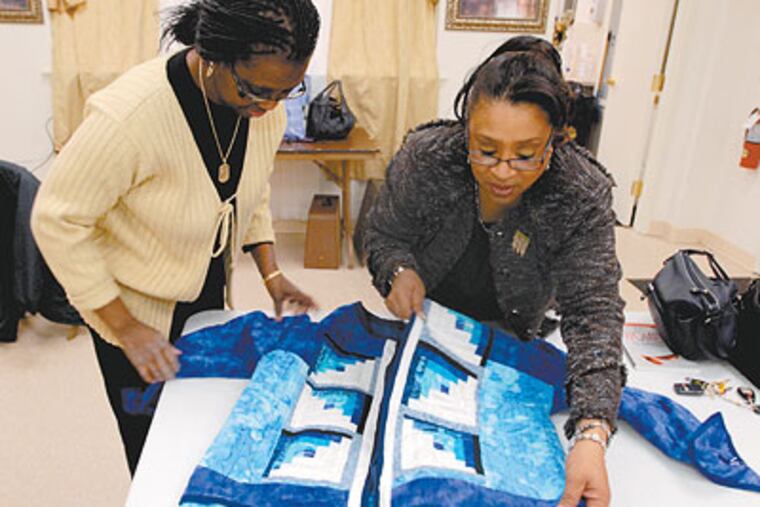Did quilts play part in Underground Railroad?
The stories of the women behind the Black History Month quilts at Second Baptist Church of Doylestown are as varied as the squares they've sewn.

The stories of the women behind the Black History Month quilts at Second Baptist Church of Doylestown are as varied as the squares they've sewn.
A mother of seven joined the group because she was lonely. Another felt the tug of a grandmother who had told her she should learn to quilt.
But through a Black History Month project on the secret codes of the Underground Railroad, the women found a joint calling.
"I'm making a quilt that has a historic meaning," group member Sandra Andrews of Lansdale said. "We're not sewing strictly for ourselves. We are sewing for a cause."
The cause in the 1800s was freedom. The occasion on Sunday will be Black History Month, when the members of the Stitchers of Faith quilting group make a presentation about what some quilt historians say was a secret language that helped slaves escape to the North.
The zigzag of the Drunkard's Path pattern meant to move in a staggering fashion to elude slave hunters. The Monkey Wrench was a signal to gather belongings for the impending escape. The Wagon Wheel meant that a wagon might be available to help in the escape.
In presenting the 15 squares, the women are holding fast to a view that many historians have challenged.
"I choose to believe," said Edna White, leader of Stitchers of Faith. "How did people know where to go, how to meet each other, go left or right?"
Quilt historian Leigh Fellner, who has done extensive research on the topic, calls the code a fantasy and urban legend.
"A number of the patterns date from well after the Civil War," Fellner said. "It's rewriting history and trivializing the real terrors and challenges that people faced in fleeing slavery."
Much of the debate is based on Hidden in Plain View: A Secret Story of Quilts and the Underground Railroad.
The 1999 book is the story of quilt codes that were part of the oral family history of Ozella McDaniel Williams, a retired school administrator who sold quilts at a downtown marketplace in Charleston, S.C.
Coauthor Jacqueline L. Tobin, an adjunct faculty member at the University of Denver, met Williams in 1994. She wrote the book with Raymond G. Dobard, an art professor at Howard University.
White, of the Stitchers of Faith, read the book and used a quilting-instruction text based on the quilts described by Williams.
But since the book's release, scholars have argued that there is no proof. Fellner called it a soft and fuzzy way to teach history that is fueling a cottage industry of books, lesson plans, and quilt-associated commercialism.
Dobard defends Hidden in Plain View as one person's story, not the story of a movement.
Tobin said she believed Williams' family code, more now than ever, because she had spoken to many people who said they had similar codes in their family history.
Maude Southwell Wahlman, a historian and an expert on African American quilts, said she saw both sides of the argument. Wahlman, a professor at the University of Missouri in Kansas City, wrote a foreword to Hidden in Plain View.
She said she believed that some information in the book was true and some possibly was invented by Williams. Wahlman sympathized with historians who say there is no documentation, but she added that there was a strong tradition of secret writing systems controlled by women throughout the African diaspora.
"It's hard to imagine that it didn't also happen in the U.S.," Wahlman said.
Local historian Charles Blockson, who is skeptical about quilt codes, urged the church group to be cautious in its presentations and remember that some of the most authentic code language came out of the church itself - in spirituals.
The quilters of Second Baptist Church are content to let the scholars chat among themselves.
History takes different shapes, the quilters said, depending on who is telling the story.
"There will always be controversy," Andrews said. "You will never get 100 percent agreement."
The group's quilt-code squares are only part of their Black History Month efforts. The women have joined with two other groups to sew quilts that will be donated to hospitalized youngsters.
In addition, they have sewn African-inspired jackets that they plan to wear to church Feb. 28.
For Lois Jones, 62, the projects stir memories of her grandmother Elvira Martin, a midwife who delivered hundreds of babies, including Jones.
Martin often told Jones to learn quilting when Jones was growing up in Tuskegee, Ala.
"I've often thought about how I wish I had her back to learn what she knew," said Jones, of Doylestown. "I can hear her laughing, talking, and telling the old stories."